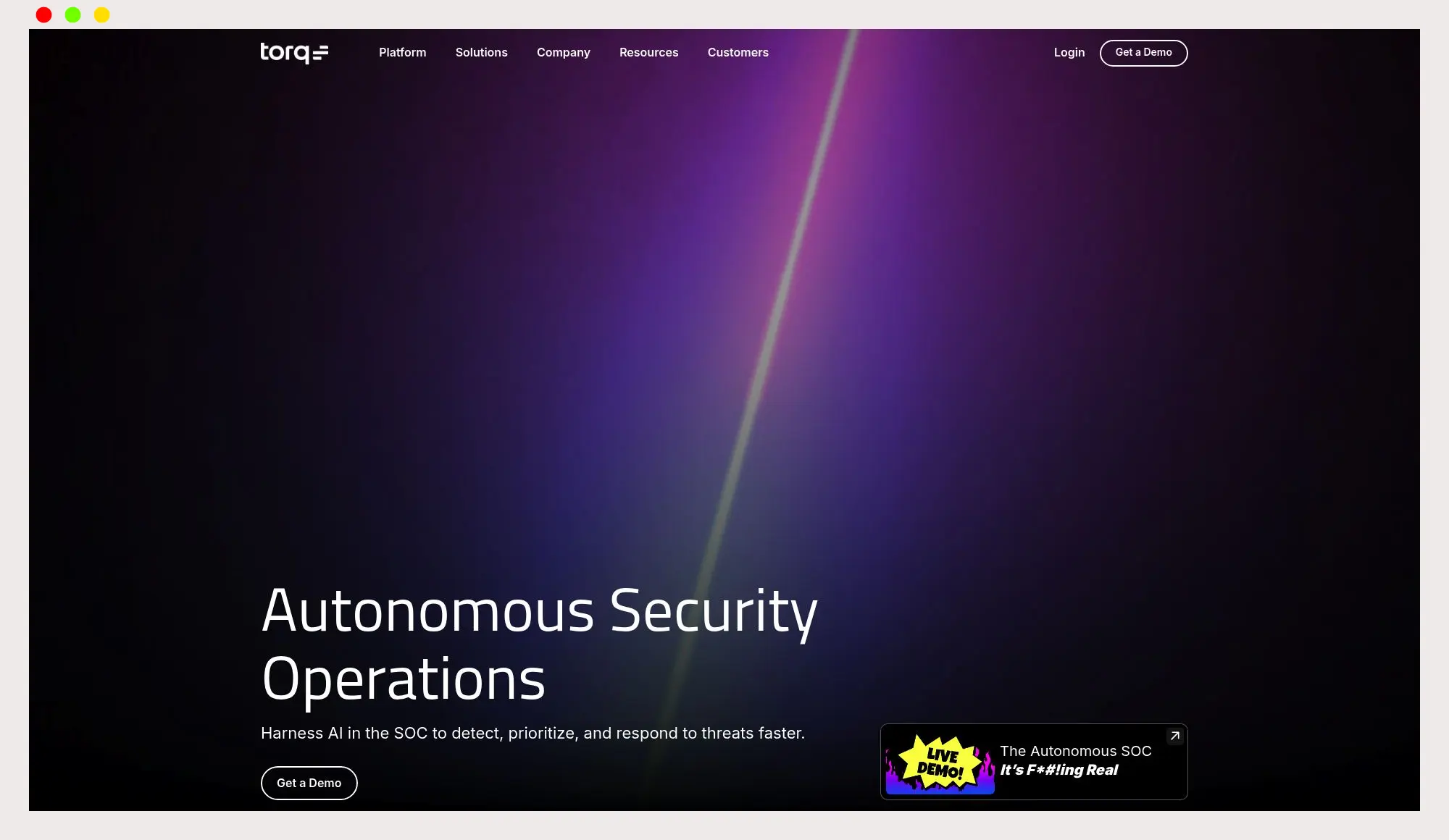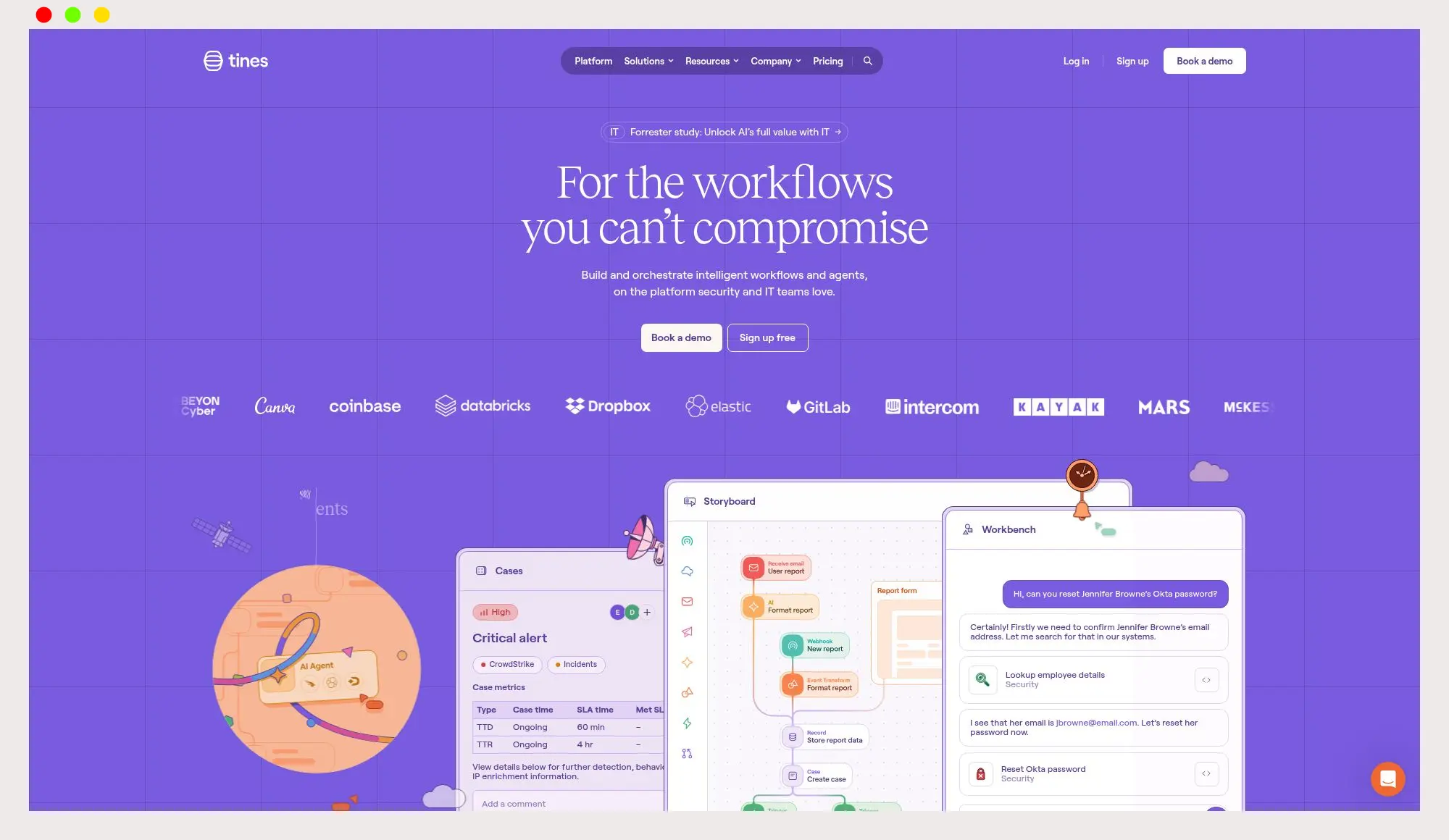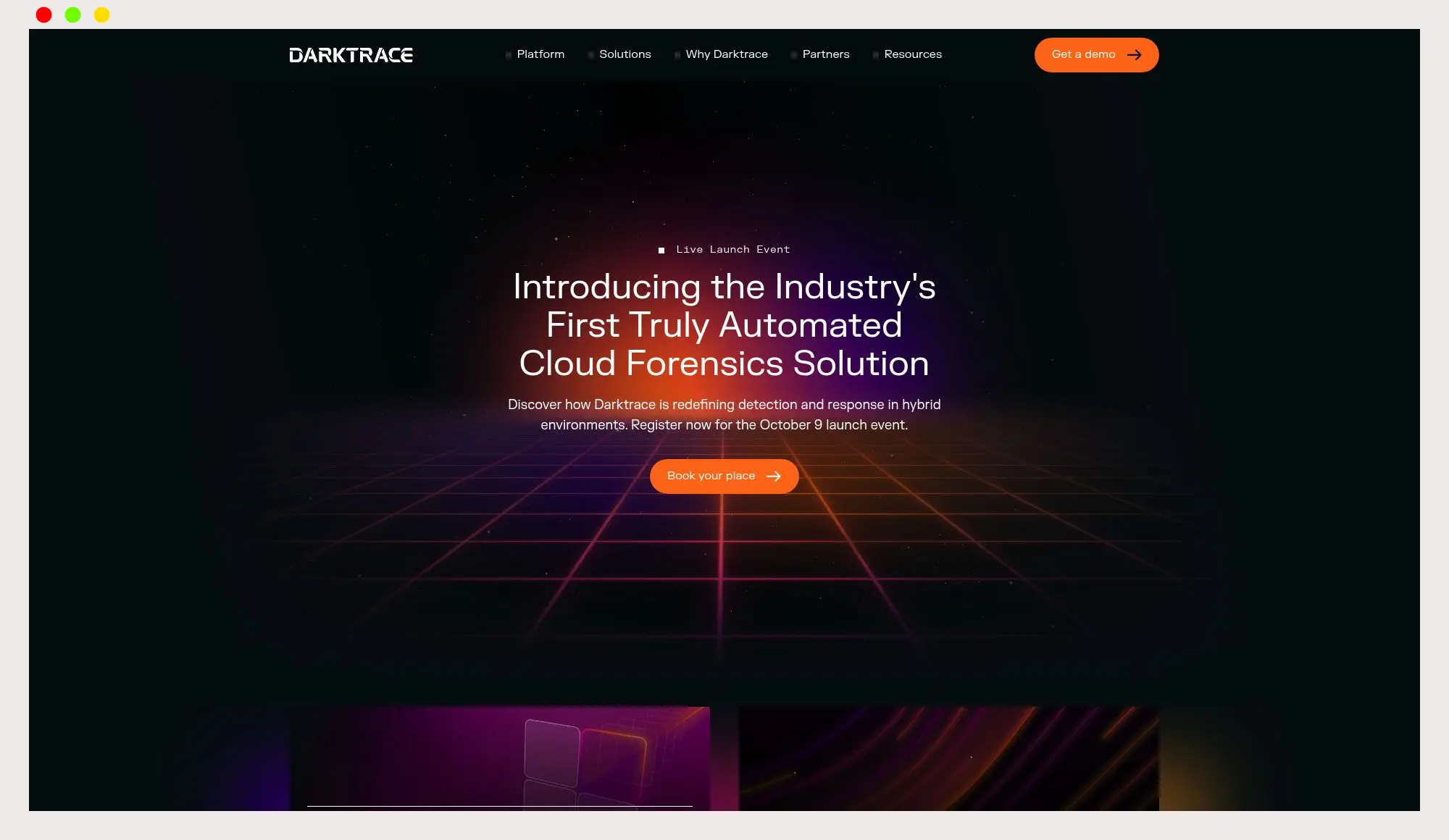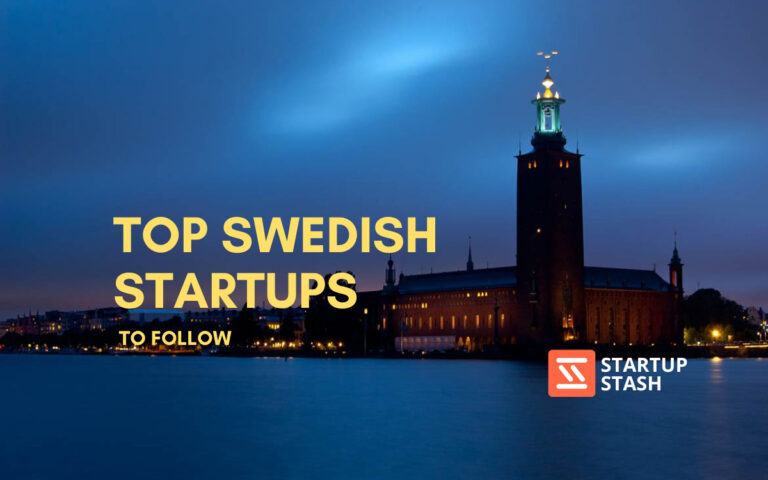You think you know where your SOC bottleneck is until a routine weekend change window floods your SIEM and identity stack at 2 a.m., while email and EDR telemetry spike in parallel. Working across different tech companies, the quickest wins I have seen come from automating three things fast, enrichment of EDR alerts with process ancestry for lateral movement, cross correlating Okta sign in anomalies with CloudTrail events, and auto isolating risky inboxes when URL detonation comes back malicious. SOCs that pair automation with analyst oversight cut toil dramatically, which matters when the average breach reached 4.4 million dollars in 2025 and extensive security AI saved about 1.9 million dollars per breach on average, per IBM’s Cost of a Data Breach 2025.
I analyzed 14 platforms in this space, then narrowed to five that consistently deliver agentic help on alert triage, investigation, and response. Market noise around “AI” is high, so I weighted provable outcomes, deployment realism, and buyer verified reviews. You will see how these tools differ, where each fits, and what to watch for on pricing and implementation, with supporting references from industry reports, marketplaces, news, and third party reviews.
Torq HyperSOC

Agentic AI SOC platform that automates alert triage, investigation, and response by coordinating multiple AI agents. Focuses on end to end workflows and case management inside one system.
Best for: Enterprises that want an AI driven SOC backbone that executes runbooks, manages cases, and closes the loop on remediation.
Key Features:
- Multi agent system coordinating runbook, investigation, remediation, and case management agents, per vendor documentation.
- Natural language to workflow, to accelerate playbook creation, per vendor documentation.
- Case management with automated summarization and status updates, per vendor documentation.
- Broad ecosystem of integrations for EDR, SIEM, identity, and ticketing, per vendor documentation.
Why we like it: In practice, Torq’s native data transforms and parallel steps shorten enrichment and containment steps that used to require custom code.
Notable Limitations:
- Reviewers note limited version control and prefer more robust git like flows, based on G2 customer feedback.
- Some users cite intermittent AI step execution issues and slower support responsiveness during growth phases, per G2 reviews.
Pricing: Public pricing appears in AWS Marketplace with 12 month contracts listed from 450,000 dollars, see the Torq HyperSOC listing. Private offers can differ in AWS Marketplace, which is common for enterprise software, per AWS Marketplace pricing documentation. Torq’s recent funding news also confirms HyperSOC’s enterprise focus and adoption, see Business Wire coverage.
Tines

Low code orchestration platform for building intelligent security and IT workflows and agents. Known for a JSON first action model and a growing “Cases” module.
Best for: Lean security teams that want to start fast, standardize playbooks, and later expand across IT operations.
Key Features:
- No code, action based workflow builder with strong API integration model, per vendor documentation.
- Incident and ticket style “Cases” to coordinate work across teams, per vendor documentation.
- AI assisted actions and transforms to accelerate data parsing and drafting, per vendor documentation.
- Option to deploy in cloud or self hosted, per vendor documentation.
Why we like it: The action library covers most security data handling without scripts, which reduces maintenance cost in smaller teams.
Notable Limitations:
- Reviewers mention debugging complex, branching workflows can be time consuming, per G2 reviews.
- Some teams want deeper native version control beyond current change control features, per G2 reviews.
Pricing: Community Edition is free, and paid plans are quote based, as summarized on the G2 pricing overview. If you need the free option to evaluate, confirm current limits there.
Prophet Security

Agentic AI SOC analyst platform designed to triage, investigate, and respond to alerts autonomously while surfacing its reasoning. Emphasizes transparency over black box outputs.
Best for: Teams swamped by alert volume that want an AI analyst to plan investigations, gather evidence across tools, and propose actionable steps.
Key Features:
- AI SOC Analyst that plans, investigates, and responds with evidence and summaries, per vendor documentation.
- Threat hunting assistant to generate leads and run scoped hunts, per vendor documentation.
- Detection advisor that recommends tuning and coverage improvements, aligned to ATT&CK, per vendor documentation.
Why we like it: The “show your work” approach reduces time spent validating AI outcomes, which speeds trust and adoption in an SOC.
Notable Limitations:
- Newer platform, limited third party customer reviews in the public domain as of September 2025, confirm maturity during evaluation, see Axios funding coverage.
- Performance claims are largely vendor reported in press, plan a proof of value with clear success metrics, see recent Series A launch coverage.
Pricing: Pricing not publicly available. Contact Prophet Security for a custom quote. Background on product scope and recent funding is covered in Axios and Business Wire syndication.
7AI

Agentic security platform that uses swarming AI agents to autonomously investigate and resolve alerts. Positions the work as “non human tasks” offloaded at scale.
Best for: Enterprises or MSSPs seeking parallelized investigations and large scale reduction of repetitive SOC tasks.
Key Features:
- Swarming agents that split an investigation into parallel expert tasks, per launch announcement.
- Connectors across cloud, identity, network, and EDR to gather evidence, per third party coverage.
- Partnership ready delivery with MSSPs, including a managed Agentic SOC service, per reported partnership news.
Why we like it: The parallel agent pattern maps well to noisy environments where dozens of lookups and hypotheses must run at once.
Notable Limitations:
- Early stage, with performance stats in press releases rather than independent studies, validate in a lab, see PR Newswire launch.
- Limited public buyer reviews as of September 2025, though partnerships suggest traction, see MSSP Alert on the DXC partnership.
Pricing: Pricing not publicly available. Contact 7AI for a custom quote. Deployment through partners is covered in MSSP Alert.
Darktrace AI

AI powered cybersecurity platform focused on self learning detection and autonomous response across network, cloud, email, and endpoint surfaces. Recognized for anomaly detection and response speed.
Best for: Organizations seeking broad behavioral detection with autonomous response across multiple attack surfaces.
Key Features:
- Self learning detection to spot anomalies beyond signatures, widely reported by users, see G2 reviews.
- Autonomous response that can interrupt malicious activity in real time, per buyer feedback in G2 reviews.
- Modules spanning network and email, with a growing product platform, referenced in recent business coverage like the Financial Times.
Why we like it: It can reduce the burden on humans during fast moving incidents, especially when tuned and supervised during early learning phases.
Notable Limitations:
- Multiple reviewers cite initial noise and a learning period to tune models, plus higher cost at scale, per G2 user feedback and PeerSpot pricing commentary.
- Community threads frequently mention a black box feel and heavy tuning needs, which require SOC time, see this Reddit discussion.
Pricing: Pricing not publicly available and often negotiated. Third party reviews describe six figure annual contracts in many cases, see PeerSpot. Disclosure, Darktrace agreed to be acquired by Thoma Bravo in April 2024 and continues to operate, buyers should confirm roadmap and contracting terms, see Reuters.
AI SOC Tools Comparison: Quick Overview
| Tool | Best For | Pricing Model | Free Option | Highlights |
|---|---|---|---|---|
| Torq HyperSOC | Enterprise SOC automation with agentic workflows | Annual contract, often via marketplace or private offer | No | Multi agent investigations and case handling, see Business Wire |
| Tines | Lean teams standardizing workflows across SecOps and IT | Community free, paid quote based | Yes | Fast build, strong API actions, per G2 reviews |
| Prophet Security | AI analyst for triage and investigation at scale | Custom quote | No | “Show your work” investigations, see Axios |
| 7AI | Parallel agent investigations for large enterprises or MSSPs | Custom quote, often partner delivered | No | Swarming agents and MSSP partnership, see MSSP Alert |
| Darktrace AI | Broad anomaly detection and autonomous response | Custom quote | No | Behavioral detection and autonomous response, per G2 |
AI SOC Platform Comparison: Key Features at a Glance
| Tool | Feature 1 | Feature 2 | Feature 3 |
|---|---|---|---|
| Torq HyperSOC | NLP to workflow creation | Multi agent investigation and remediation | Native case management |
| Tines | Action based low code builder | Cases for incident coordination | AI assisted transforms and actions |
| Prophet Security | AI SOC Analyst plans and investigates | Threat hunting assistant | Detection tuning advisor |
| 7AI | Swarming parallel agents | Broad connectors across cloud and identity | Context aware conclusions |
| Darktrace AI | Self learning anomaly detection | Autonomous response actions | Coverage across network and email |
AI SOC Deployment Options
| Tool | Cloud API | On-Premise | Air-Gapped | Integration Complexity |
|---|---|---|---|---|
| Torq HyperSOC | Yes | Not publicly documented | Not publicly documented | Varies by environment and number of systems connected |
| Tines | Yes | Self hosted option available, per vendor documentation | Not publicly documented | Generally low to medium per G2 user feedback |
| Prophet Security | Yes | Not publicly documented | Not publicly documented | Plan a POV for data access and identity scopes, see Axios |
| 7AI | Yes | Not publicly documented | Not publicly documented | Frequently delivered with MSSPs, per MSSP Alert |
| Darktrace AI | Yes | Yes through appliances and sensors, per buyer reports | Not publicly documented | Medium during model tuning, per G2 reviews |
AI SOC Strategic Decision Framework
| Critical Question | Why It Matters | What to Evaluate | Red Flags |
|---|---|---|---|
| Can it prove time savings on your top three alert types | Reduces breach cost and burnout | Side by side MTTR and investigation steps before and after | Only demo data, no measurable pilot plan |
| Does the platform show its work | Lowers validation overhead | Access to evidence, steps, and reasoning trails | Black box output with limited artifacts |
| How does pricing scale | Prevents budget surprises | Contract terms, metering units, marketplace options | Opaque pricing, unbounded usage costs |
| What is the deployment path | Shortens time to value | Connectors, permissions model, data residency | Long security review with unclear data flows |
| How does it fit your existing stack | Avoids tool sprawl | Prebuilt integrations and webhook patterns | Heavy services required to integrate basics |
AI SOC Solutions Comparison: Pricing and Capabilities Overview
| Organization Size | Recommended Setup | Monthly Cost | Annual Investment |
|---|---|---|---|
| Small team, under 500 employees | Start with Tines Community Edition to codify triage and response, expand if needed | Free for Community, paid tiers are quote based per G2 pricing | Not publicly available |
| Mid market, 500 to 5,000 employees | Tines paid tier or Torq pilot on core detections, plus email containment automation | Not publicly available | Torq public marketplace shows 450,000 dollars per year options, see AWS Marketplace |
| Enterprise, over 5,000 employees | Torq HyperSOC or 7AI with an MSSP partner, run a 60 day proof of value on noisy alerts | Not publicly available | Custom quotes, see MSSP Alert on 7AI partnership |
| High compliance or critical infra | Darktrace AI for behavior based detection and autonomous response, with strict human in the loop rules | Not publicly available | Often six figures annually depending on scope, per PeerSpot |
Problems & Solutions
-
Problem, Alert triage backlog doubles after adding new cloud accounts
- Torq HyperSOC, Use NLP to convert triage steps into workflows and let investigation and remediation agents run in parallel. Torq positions HyperSOC to automate investigation, triage, and remediation at scale, per Business Wire.
- Tines, Start with a JSON action based workflow to enrich alerts from SIEM and EDR, then open a case only when key conditions are met. Teams highlight ease of integration and rapid workflow creation in G2 reviews.
- Prophet Security, Offload triage to the AI SOC Analyst which plans the investigation, gathers evidence, and proposes response, the company’s launch and funding coverage describe this scope, see Axios.
- 7AI, Dispatch swarming agents to run cloud, identity, and network checks in parallel and compile conclusions for analysts, per PR Newswire.
- Darktrace AI, Lean on autonomous response to contain abnormal activity while the SOC validates, buyers report strong real time actions in G2 reviews.
-
Problem, After hours containment is slow and risky
- Torq HyperSOC, Pre approve actions like MFA challenges or temporary account lock for certain severities so the remediation agent executes immediately, aligned with statements in Business Wire.
- Tines, Use webhooks from EDR to trigger isolation actions through an orchestration flow and create a case for follow up. Users cite simple API connectivity in G2.
- Prophet Security, The AI analyst proposes response steps and can push to tickets or chat for one click execution during off hours, scope described in Axios.
- 7AI, Agents can run the investigation, calculate blast radius, and prepare recommended actions for an on call human to approve, per PR Newswire.
- Darktrace AI, Autonomous actions can throttle or block activity until an analyst reviews, numerous reviewers reference this capability in G2.
-
Problem, Executives need proof that AI reduces breach exposure
- Anchor your business case to IBM data, the 2025 study shows the global average breach cost at 4.4 million dollars and 1.9 million dollars in savings when AI is used extensively, link the pilot’s KPIs to these drivers, see IBM’s 2025 report.
Community Reflections: What Real SOC Teams Are Saying
While tools like Torq HyperSOC, Tines, Prophet Security, 7AI and Darktrace AI promise to automate triage and response, frontline practitioners still wrestle with cost, integration gaps and the need for human oversight. These Reddit discussions illustrate why careful evaluation matters.
AI SOC – Truth or Dare? (r/cybersecurity, Jul 2025)
In a thread sparked by hype around AI‑driven SOC platforms, the top comment cautioned that automation is still an assistant, not a replacement:
“At best AI is a workforce amplifier… That said, we’re about to see growing pains. Pricing will skyrocket… There’s also a lot left on the table… because they’d rather you pay the premium for you to DIY it.”
Another responder noted that current platforms often lack out‑of‑the‑box integrations:
“We’ve been onboarding / deploying them for the past couple of months. The biggest downside so far is they have limited integrations already developed for the platforms we use… Still recommend them for an IR and SOAR platform, as long as you’re not looking for a turn‑key platform to tie fifteen tools together.”
These remarks echo our own emphasis on verifying vendor claims around ecosystem breadth and pilot results before committing to high‑priced AI SOC offerings.
🔗 View this discussion on Reddit
Would an Automated SOC Be Useful? (r/AzureSentinel, Mar 2025)
A post about building an automated SOC for Sentinel triggered a sober conversation about false positives and user segments:
“How are you going to keep the false positive rates down? … All it took was for one person to get falsely quarantined during an important client meeting… You have to be 100 % sure before doing 100 % automated workflows.”
Another commenter, who’d been designing SOC platforms for years, stressed tailoring automation to the right audience:
“Small/mid‑sized companies just want compliance. Large companies are looking to cut costs. Service providers spend almost half their time documenting actions; the part that causes most frustration was triaging certain incidents… If you’re a solo developer, I’d suggest trying to nail one segment instead of trying to span too broadly. Get to know your users’ everyday issues.”
Those insights align with our recommendation to pilot automation on specific alert types and to assess whether tools like Tines or Torq fit your org’s size and complexity.
🔗 View this discussion on Reddit
Are AI SOC Analysts the Future or Just Hype? (r/cybersecurity, Mar 2025)
A lively debate about AI SOC analysts captured both skepticism and cautious optimism. One highly up‑voted comment summed up current limitations:
“They’re scaffolded to hell, the demo scenarios are all propped up. There’s no real reasoning being done by the AI SOC analysts. … Right now they should just be there to augment the information in front of someone to help them make an informed decision.”
Another practitioner was blunt about the hype cycle:
“I’ve tested some during 2024 and all were pure garbage. No company has presented a good use case yet… MSSPs can use them to ship [junk] because none cares but seems none is usable if you want security.”
Yet a user who deployed Dropzone AI shared a contrasting success story, describing how the tool culled half a million alerts down to a handful of relevant events each day:
“It turns the toil of tuning and managing massive alert volumes into less than an hour a month… It’s what people wish SOAR was… The rest of the vendors I agree, most are useless hype. But Dropzone won two POCs and saved hundreds of thousands a year by slimming down the alert pipeline.”
This mix of criticism and real‑world success underscores our conclusion: AI SOC platforms can reduce toil when paired with tuned playbooks and analyst review, but buyers should test carefully and not expect a turnkey panacea.
🔗 View this discussion on Reddit
Bringing these insights back to your research, the overarching lesson is clear: evaluate AI SOC tools on measurable reduction in false positives and manual toil, ensure they integrate with your existing stack, and keep experienced analysts in the loop. Use community feedback as a compass, not a substitute for your own proof‑of‑value.
Bottom Line
Security AI is no longer optional hype, it now maps to measurable savings when used extensively in operations according to IBM’s 2025 Cost of a Data Breach. Torq HyperSOC suits enterprises ready for an AI led SOC backbone, Tines is a pragmatic entry point for building reliable workflows, Prophet Security and 7AI are agentic newcomers worth piloting on high volume alerts, and Darktrace AI offers broad behavioral coverage with autonomous response. Run time boxed proofs with clear MTTR, false positive reduction, and containment metrics, and validate pricing with marketplace or third party references before you commit.


